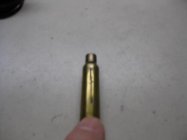I just got a nice PM from CatShooter asking a few questions, so here goes.
It is once fired Remington .223 cases fired by our police, and I'm beginning to think the cases were seconds and rejected for standard ammunition. The cases were resized with a RCBS small base die and then the necks were expanded with a Sinclair expander die. The neck thickness was checked with a Redding case neck gauge.
So far only three cases had variations as large as .006 to .008 and these variations were not caused by dents or dings in the brass. The majority of the case necks are between .011 and .013, but a few sneak in that are .009 to .014. Added to this is its all mixed brass with weight variations and variations in flash hole web thickness.
I'm just starting to load some 69 grain SMK and want to load some "accurate" ammunition that will be fired in two different AR15 rifles with "large" military chambers. Meaning how picky should I be with a military type rifle?
Is .002 still a good standard for neck wall thickness? One AR15 is a 20 inch A2 HBAR (iron sights) and the other is a 16 inch carbine with a 1 to 3 powder scope.
I just want to find out what these two rifles are capable of, I only have 50 new Winchester cases that are very uniform compared to the Remington cases. Should I just load the Remington cases with 55 grain fmj and use it for blasting ammo. Again I have never seen cases before with so much variations in neck thickness, BUT I have never used mixed range pickup brass before either.
When I first got this free brass it was like a giant Christmas present but now I think Remington subcontracted this brass to China.

It would be nice to have input from AR15 shooters, both rifles are factory rifles with standard chrome chambers and bores.
As a side note I wouldn't be asking this question if I could buy new .223 brass, but the only thing available even now is once fired military type brass. And I was saving the new Winchester brass for my bolt action .223.












